Today's Thai Chefs Bring a Fresh Mindset to Bangkok's Food Scene
The next generation of Thai chefs is reinterpreting ancestral flavors, with delicious results.
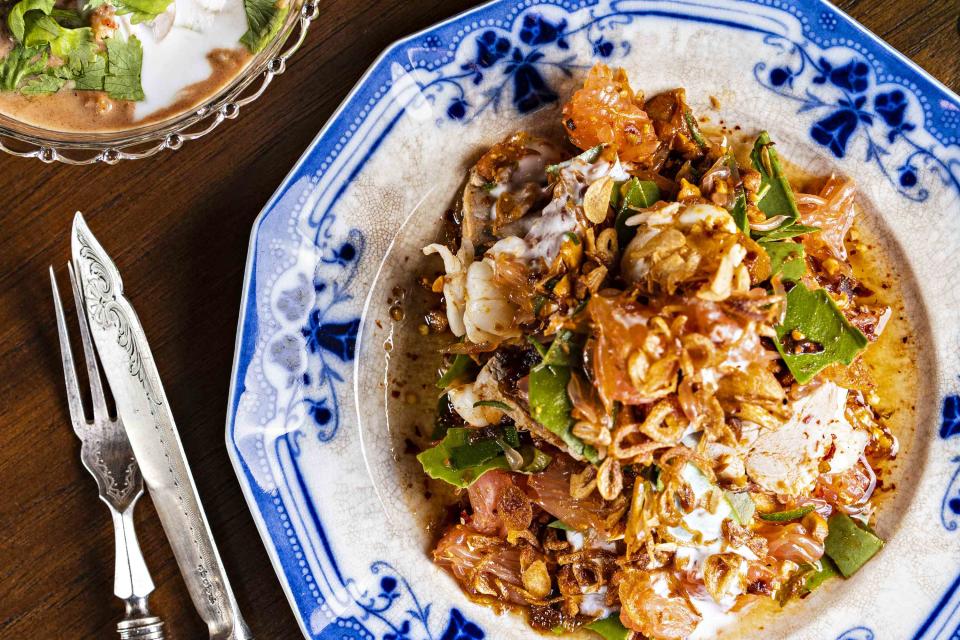
Chris Schalkx
At Potong, a Thai Chinese fine-dining spot hidden in Bangkok’s labyrinthine Chinatown, every guest will find a letter to chef-owner Pichaya Soontornyanakij’s grandparents beside their plate. “What I am trying to do is not only to save traditional inspiring ingredients from being forgotten,” Soontornyanakij writes, “but also to create a bold new genre that still respects the ingredients used back then at your little Thai Chinese kitchen on the balcony.” The ensuing 20-course tasting menu reads like a love letter to Soontornyanakij’s ancestors, who for five generations have run their herbal-medicine business from this timeworn building that quivers when tuk-tuks rattle through the alley in front.
One of the first courses is a take on rad na, the rice noodle dish in thick gravy cooked in kitchens around the area. Soontornyanakij mimics the texture with vinegar jelly and swaps the usual straw mushrooms for morels and caviar. It’s followed by an herbal crab broth, the aroma of which evokes a walk through Yaowarat, Chinatown’s spice shop–lined main drag. Entrées, served on a rotating tabletop tray, consist of dry-aged duck, sweet beef char siu, and a Szechuan pepper–spiked take on kai toon (steamed egg custard) layered with minced duck leg that jiggles like mapo tofu. The price? A far cry from those inexpensive delights sold just outside.
When I traded my native Holland for a new home in Bangkok a decade ago, spending a three-digit sum on a Thai meal was a rare occurrence. For those who could afford it, blowout budgets were earmarked for elaborate Cantonese banquets served in the gold-trimmed dining rooms of the city’s five-star hotels, or fine French and Eurocentric fusion restaurants set in the stately wooden villas of Bangkok’s swankiest neighborhoods. Diners who did splurge on Thai cuisine mostly had the opportunity to do so at restaurants serving royal Thai tasting menus, the type of hyper-refined cooking — think delicately plated river prawns, ornately carved fruits, and one-bite appetizers wrapped in betel leaf and lotus petal — with roots in the royal palace kitchens of 14th- to 18th-century Thailand.
But when rumors of the Michelin Guide’s Thai debut started swirling around dining rooms in 2016, the tide turned. With localized editions of cooking shows such as MasterChef and Top Chef launching around the same time, a culinary trend swept through the city. International awarding bodies started doling out accolades left and right. And though the spotlight was still on foreign gastronomy in those early days, Thai restaurants such as Nahm, Sorn, and Le Du slowly crept to the top ranks in the years that followed.
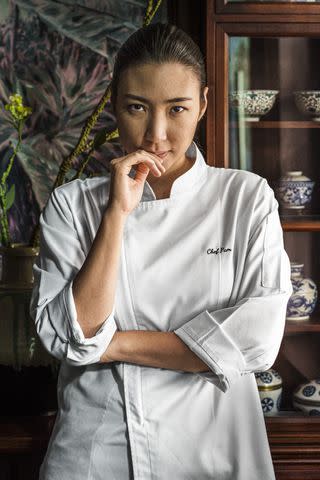
Chris Schalkx
Chef-owner Pichaya “Pam” Soontornyanakij has won local and international acclaim for her Thai Chinese restaurant Potong in Bangkok’s Chinatown; she is also a regular judge on Top Chef Thailand.“Diners have become a lot more educated when it comes to appreciating culinary craftsmanship,” says food journalist Pruepat Songtieng. “Why does Thai food always have to be financially humble? Our cuisine is rooted in more than a thousand years of heritage and history. It takes great effort to make a fine curry paste, which is just as difficult as perfecting a good béchamel, if not more difficult. People are now less shy to put Thai craft as equal to any popular cuisine in the world.”
This fresh mindset — along with bigger budgets — emboldened a new wave of young Thai chefs like Soontornyanakij to start spotlighting the recipes of their heritage. No longer were European degustation menus the only route to financial success and culinary stardom. Historical cookbooks and regional street-food staples suddenly became the inspiration for samrub-style (Thai shared dining) menus that could carry just as much cachet.
The shift also spurred a renewed appreciation and demand for local produce. “In the past, we used to have this belief that imported ingredients were always better and gave you a higher ranking on the social ladder,” says Chalee Kader, who was one of the first high-profile chefs to zero in on Thai-raised meat at his nose-to-tail restaurant 100 Mahaseth, which opened in 2017. “Now, chefs are sourcing hard-to-find and high-quality local ingredients from every corner of the country, which are given importance at the dinner table through a new way of storytelling that never really existed back in the day.”
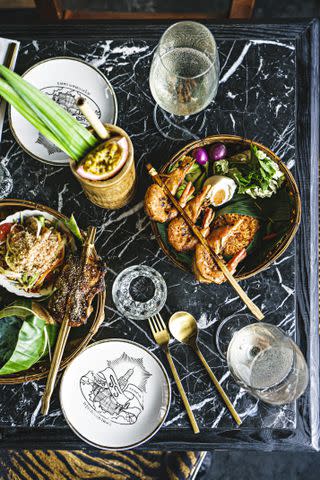
Chris Schalkx
Funky rooftop spot Rongros serves a vibrant array of noodle dishes, grilled meat, and seafood.At Kader’s latest venture, Wana Yook, set in a 100-year-old lemon-yellow mansion in the bustling Ratchathewi district, he riffs on Thailand’s ubiquitous khao gaeng curry-and-rice counters, which during breakfast and lunchtime fill streets around the country with the metallic clatter of ladles scooping brightly colored curries and spicy stir-fries over heaps of rice. On a recent visit, Wana Yook’s maître d’ proudly explained the origins of each hyper-local rice variety that the 12 courses of chile-laden tom jiw beef soup and sour chamuang pork curry were paired with.
These days, Bangkok is also home to a fancy iteration of almost every regional Thai cuisine you could point your compass at. The aptly named North, on a quiet side street in the Lower Sukhumvit district, makes dishes from Thailand’s northern provinces the centerpieces of the menu, while Supaksorn Jongsiri’s hot-ticket Sorn has bagged two Michelin stars for its Southern Thai tasting menus. At Sri Trat, a portrait of the proprietor’s Eastern Thai matriarch peers over the teak-accented dining room, where customers enjoy the kind of seafood-centric soups and relishes she shared with her family. And at Zao, a concrete-clad wine bar and restaurant in the hip Ekkamai district, owner Eve Nutthida Palasak turns to garlic-flecked pla yon (deep-fried freshwater fish) and a dozen or so som tum varieties with punchy pla ra (fermented fish paste) to set the record straight on Northeastern Thai cooking. “Many people think Isan food is too spicy and unsophisticated,” she says. “But the dishes I grew up with were actually very complex, with lots of herbs and ingredients you won’t easily find in Bangkok markets.”
All over the city, chefs are drawing on traditional flavors to reflect a new facet of Thai cooking. “Thai food is one of the best cuisines in the world,” Kader says. “But I feel its true value is just now being realized.”
Where to stay
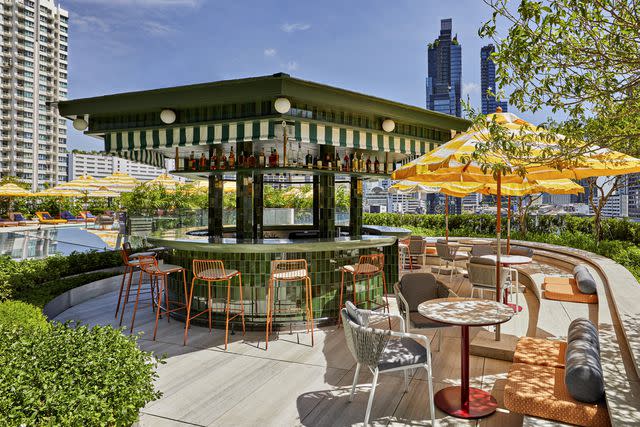
Courtesy of Standard Hotels
The rooftop bar and pool at The Standard hotel.The Peninsula Bangkok
From the western bank of the Chao Phraya River, this grande-dame hotel offers rooms adorned with teak, swirls of gold, and licks of jewel-toned silk, plus a dazzling view of downtown Bangkok’s skyscraper jungle. Rooms from $385
The Standard Bangkok Mahanakhon
Stretching from the eighth to the 18th floor of the pixelated-looking King Power Mahanakhon skyscraper, this fun-filled property swaps the typical beige look of most of Bangkok’s five-star spots for rooms featuring eye-popping colors and bold curves. Rooms from $172
Baan Tuk Din Hotel
Taking over a century-old home with clapboard walls, this 19-room boutique hotel delivers antique-studded suites and a jazzy cocktail bar. Its perch in a small courtyard just off Dinso Road puts street-food stalwarts such as Pad Thai Thipsamai and Jay Fai’s legendary crab omelets within easy walking distance. Rooms from $52
Where to eat and drink
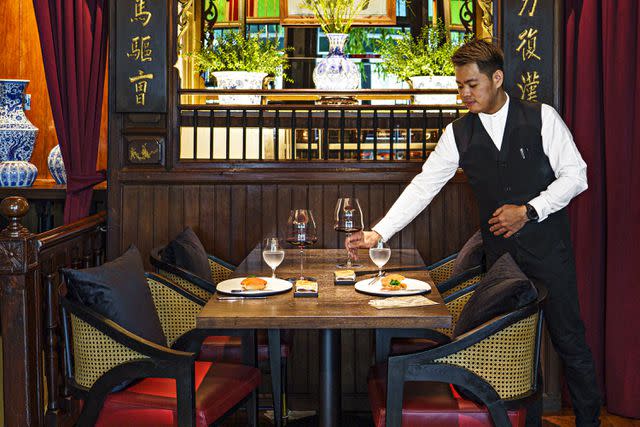
Chris Schalkx
Thai Chinese fine-dining spot Potong opened in 2021 and has won many awards since for its modern approach to ancestral food traditions. The restaurant is housed in a building that has been in chef-owner Pichaya Soontornyanakij’s family for five generations.Potong
From the stamp-size kitchen of a five-story historic building, Pichaya Soontornyanakij puts a fine-dining spin on Chinatown’s street-food classics and recipes from her Thai Chinese family. Don’t miss the bar for an excellent nightcap. restaurantpotong.com
Zao
Using ingredients brought in twice a week from a wet market in Northeastern Thailand, this restaurant showcases Isan cooking with dishes such as som tum. instagram.com/zaoisan
Aksorn
Australian chef David Thompson, a Thailand resident since 1988, draws on his extensive library of Thai culinary literature from the 1940s to 1970s for multicourse rice-and-curry dinners at this rooftop spot. Leave room for dessert: The candle-smoked coconut khanom bites are sublime. aksornbkk.com
Sorn
Tables at this tony spot require bookings months in advance, but those lucky enough to snag one will be rewarded with chef Supaksorn Jongsiri’s Southern Thai curries, chargrilled seafood, and indigenous herbs and vegetables. instagram.com/sornfinesouthern
North
Nam phrik num (chile relish), khantoke (curry sets), and other staples from Thailand’s mountainous north inspire the tasting menus at this mansion in the Sukhumvit district. The Wagyu khao soi from the à la carte menu makes for an excellent lunch. north-restaurant.com
Sri Trat
Sri Trat’s family-style meals draw on recipes from Eastern Thailand. The kapi shrimp paste and fish sauce, key ingredients in most of the dishes, are imported from the Trat province to guarantee real-deal flavors. instagram.com/sritrat
Wana Yook
Chalee Kader pays homage to Thailand’s ubiquitous curry counters in a 12-course menu that changes with the seasons. Thankfully, the crowd-pleasing fish sauce–cured egg yolk on fried-to-a-crisp egg-white fluff is a permanent fixture. instagram.com/wana.yook
Rongros
Pitched up across the river from the Wat Arun temple, Rongros’ rooftop terrace is a sought-after spot for cocktails spiked with lao khao (a rice-based Thai moonshine). Stick around for dinner, which zeroes in on comforting Central Thai dishes such as rib eye krapow and watermelon cubes with sun-dried snakehead fish. rongros.com
Tax Bar
From the owners of gin-centric Teens of Thailand down the street, this grungy hangout in Chinatown’s Soi Nana bar hub mixes umami-packed cocktails using housemade ingredients such as cumin-flavored shrub and kombu stock, as well as their own drinking vinegars made from Riesling and sake. instagram.com/tax_bar_bkk
F.V
At this art-studded juice bar, creative director Opas Chantkam turns blemished fruits and often-exterminated weeds such as maiyarap (shameplant) into pulpy drinks and health-boosting herbal teas. Even the bar’s glassware, made from upcycled beer bottles, stays true to Chantkam’s eco ethos. instagram.com/fv_bkk
For more Food & Wine news, make sure to sign up for our newsletter!
Read the original article on Food & Wine.

